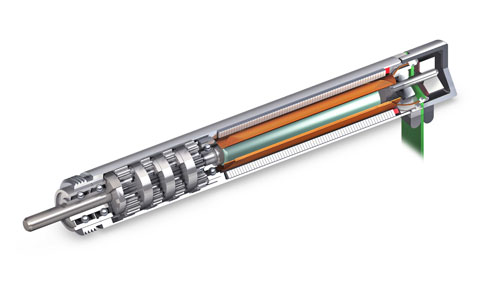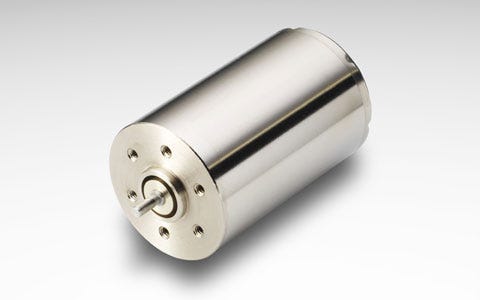Dc motors can deliver high precision, light weight, and high efficiency in a limited amount of space.
June 26, 2015

Frank Vinluan
As motors get smaller, their power diminishes, a limitation that Maxon Precision Motors overcomes with improved winding technology and powerful magnets in its EC 4 4mm brushless motor. |
Motors are crucial components in modern medical devices, fulfilling requirements that call for tremendous mechanical power delivered from within a small footprint. Think of surgical and dental tools, for example, that offer a lot of power from a small handheld device. But the motors that drive medical devices also play an integral role in manufacturing them. In a medical device manufacturing facility, these motors have applications in conveyor belts, screwdrivers, and pick-and-place robots, among other uses.
Medical device manufacturers use dc motors where they require high precision, light weight, and high efficiency—all in a limited amount of space, says Steffen Zeller, sales manager for Maxon Precision Motors (Fall River, MA). The motor selected for an application depends on the requirements of the job. But in general, dc motors are used when a machine must perform with accuracy and repeatability in environments that present challenges such as high temperatures or physical vibrations.
The dc motors used in medical device manufacturing fall mainly into two types, brush and brushless, explains Brandon Steinberg, business development manager for North America at Portescap (West Chester, PA). The brush dc motor is an older and simpler technology, but these motors offer high efficiency and are operated with a simple control—the motor’s speed is proportional to the voltage applied. However, the design of a brush dc motor requires the spinning rotor to be in electrical contact with power supply. Wear occurring at this point of contact limits the speed and life of the motor.
|
The Portescap 26N58, a brush dc motor, was designed to reach up to 80 percent efficiency while also maintaining a long life. |
A brushless dc motor, on the other hand, does not have brushes to conduct the electrical current. Brushless motors offer higher speeds and longer life, Steinberg says. But brushless motors can be more expensive, and they require a complex controller for even the simplest operations.
Depending on the application, a manufacturer can consider a third type of motor. A stepper motor divides each rotation into an equal number of steps, which is useful in applications where keeping track of the motor’s position is particularly important, Steinberg says. Stepper motors have no brushes that limit the life of the motor, but these motors have limited speed and limited efficiency.
The biggest advances in dc motors—improvements in speed, efficiency, and motor life—happened decades ago. Recent improvements in dc motors include increasing the power output without increasing the motor’s size, Zeller says. Also, new encoders now address the challenges of operating under high temperatures, physical vibrations, and strong magnetic fields. The main consideration manufacturers should take into account when selecting a motor is the efficiency, Steinberg says.
“Lower efficiency means more heat generation—heat generation is a killer for a motor,” Steinberg explains. “The hotter it is, the faster you’re going to burn through the insulation in one of the wires, which leads to failures.”
The push for power density in motors—packing more torque into smaller and smaller spaces—comes from the evolution of medical devices into smaller and smaller products that are handheld or portable, Steinberg said. Surgical preference is also a factor in the increasing need for power density. For example, devices that once had a pistol grip will have an even smaller form factor when redesigned with a pencil grip. Size is also a consideration for larger pieces of equipment that take up precious space in an operating room or laboratory. The smaller the devices can be made, the more room these facilities can have.
Selecting a motor comes down to the application and the requirements of the job, though Steinberg notes that there is some overlap among the motor technologies. Pick-and-place robots, for example, could use any of the three motors. Medical device manufacturers can use brush motors in drills, screwdrivers, and fluid dispensers. Brushless motors are used also used in drills and screwdrivers, as well as in conveyor belts and spindles. Stepper motors are found in printing and labeling equipment, and fluid dispensers.
Both brush and brushless motors offers high power and high speed, Steinberg says. If longevity is the priority, he recommends a brushless motor, which could last a manufacturer 20 years. If cost is the main consideration, stepper motors are the lower cost option. But cost and longevity aren’t the only considerations. When selecting a motor, manufacturers can overlook the performance requirements, or the boundary conditions could change.
“If such changes don’t result in a motor or application failure, the motor or application’s performance can suffer,” Zeller says.
In some cases, manufacturers move forward on their plans without giving full consideration to the type of motor they need for the application. Putting off motor selection until later in the planning process could limit their motor options, Steinberg says. In some cases, manufacturers make assumptions that a motor can achieve a certain efficiency or reach a certain amount of torque. But those assumptions might be beyond a motor’s capabilities.
“When it comes time to find a motor, the manufacturer ends up compromising on the design,” Steinberg says.
Don't miss the MEDevice San Diego conference and expo, September 1–2, 2015. |
Frank Vinluan is a freelance contributor to MD+DI. Reach him at [email protected].
You May Also Like



